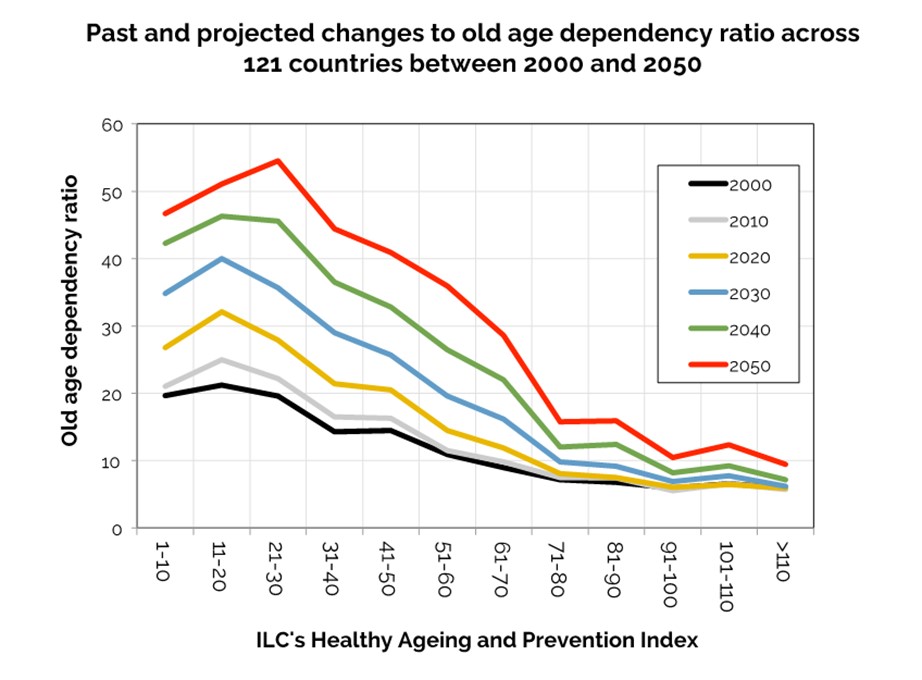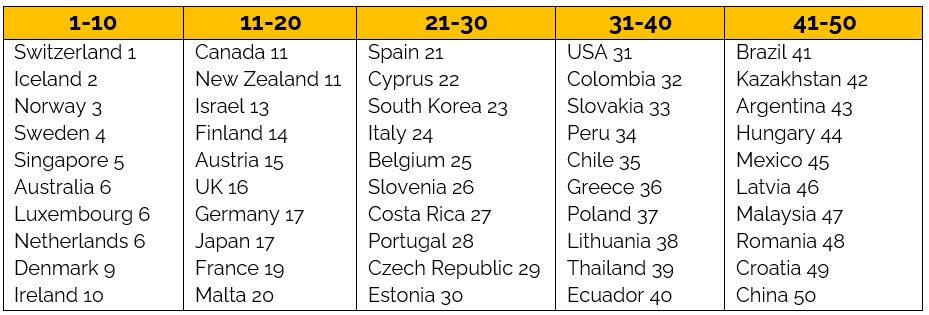The UK and other ageing populations will have to increase their state pension age to 71 by 2050 to maintain the number of workers per retiree
The International Longevity Centre’s Healthy Ageing and Prevention Index ranks 121 countries against six indicators: life span, health span, work span, income, environmental performance, and happiness.
However, most of those countries ranked at the top of the Index have rapidly ageing populations making it increasingly important for these governments to act to support healthy ageing.
To illustrate this, we have mapped the projected changes to the old age dependency ratio between 2000 and 2050 and considered the economic impact of inaction.

Data source: Wittgenstein Centre
What the data tells us
The dependency ratio used here is the percentage of people aged 65+ relative to the working adult population (aged 15 to 64). This internationally recognised measure does not include children under 15 or account for economic inactivity amongst ‘working-age’ adults or those who work beyond the age of 65.
Our analysis compares changes in the ratio over time based on the ILC’s Healthy Ageing and Prevention Index ranking of each country in 2019.
It shows that high-ranked countries are ageing at a very rapid rate compared with lower-ranked countries which will lead to widening demographic imbalances over time.
At pension age 65, a ratio of 20% equates to 5 workers per retiree but a ratio of 50%, which is projected for at least 20 countries on the Index by 2050, means just one worker per retiree.
What does this mean for the UK?
In the UK (ranked 16 on the ILC Index) state pension age would need to be 70 or 71 compared with 66 now to maintain the status quo of the constant number of workers per state pensioner.
However, if instead we define the UK’s working adult populations as 20 to 64 years, to account for time spent in full time education, the state pension age might need to hit age 70+ as early as 2040 to maintain the current dependency ratio. The recent stalling in life expectancy during the austerity years and COVID has temporarily eased the pressure for increases in state pension age beyond 67 after 2027 but longer-term the pressure will be on to increase it to 68 or 69 before that.
But while we are facing ill health earlier in our long lives, the problem becomes even more pressing because of the exit of workers from the workforce long before they reach state pension age as it reduces the tax base to pay for pensions.
Poor health is one of the key reasons for this and is one of the greatest barriers to economic prosperity faced by the UK today because it lowers economic output and increases taxes.
Additionally. a smaller working population and a large economically inactive population create huge labour shortages which must be filled by migrant labour which creates additional problems.
One solution is enabling people to work for longer but this is challenging – for example, research shows that by age 70, only 50% of adults are disability-free and able to work.
If the proportion of the economically active population were to increase from current levels of around 78% to 85% then it may be possible to hold the state pension age at below 70 from 2040 – at least for a few years.
What happens next?
Even with increases in state pension age, the growing burden of preventable ill-health will continue to act as a key barrier for people to remain in the labour market.
Indeed, ILC research finds that in Europe alone, people who report being in good rather than poor health are over four times more likely to be in work between the ages of 50 and 65, and over 10 times more likely between the ages of 65 and 74.
But ill-health isn’t an inevitable consequence of living longer. The global disease burden could be reduced by about 40% over the next two decades using interventions that already exist today; over 70% of those gains could be achieved through preventative policies.
Encouraging people to work for longer allows countries to adapt to an ageing society especially if accompanied by a well-funded pension system as a bulwark against poverty.
Our research also suggests a greater focus is needed on preventing ill-health not just in old age but from early age through adulthood. We know, for instance, that the longest health spans are in countries which spend most on prevention and adult immunisation.
Policymakers can no longer ignore the impact of poor health on wider society and doing so will simply make wider policies related to work or pensions ineffective.
Without effective long-term action, growing age imbalances will become an increasingly powerful driver of migration flows as now, but not exclusively between richer and poorer countries.
However, this is not a sustainable solution and will be to the economic and social detriment of the countries of origin as well as destination.
What should happen next
The ILC’s latest report One hundred not out: A route map for long lives, published in December 2023, sets out the challenges facing the UK’s ageing population and gives serious consideration to how we might build an adequate income to support long lives.
Younger people don’t have the financial assets that their parents and grandparents did. In 2010, those under 40 held just £7.53 of every £100 of wealth. Over the past decade, this has fallen significantly to only £3.98. The UK’s 14 million Gen Xers save just £200 into their pension pots each month on average – one-third of this group are at high risk of retiring on insufficient income. By 2046 around one in eight people aged 65 and over will be renting their home.
In One Hundred Not Out, we argue that we should move forward quickly on increasing auto-enrolment minimums while developing systems to auto-enrol self-employed people. We also call for an innovation fund to help develop workable mechanisms that would support those working in the gig economy to save.
However, it’s unlikely that the current policy consensus will drive the changes needed to ensure that future generations of older people have the same opportunities as their predecessors. This means we need to seriously explore the case for bolder government and employer interventions that would drive and support behaviour change among individuals. The report includes a mix of next-step solutions, bolder ideas, and international examples that we believe could work to tackle them.
Sources
Breakdown of dependency ratio figures. Countries ranked 11-40 on the ILC’s Healthy Ageing and Prevention Index are projected to have a dependency ratio of over 50% by 2050:

The top 50 countries by global ranking in the ILC’s Healthy Ageing and Prevention Index:

You can view the full list of countries in our Healthy Ageing and Prevention Index here.

Professor Les Mayhew & Arunima Himawan
ILC's Associate Head of Global Research & Senior Health Research Lead